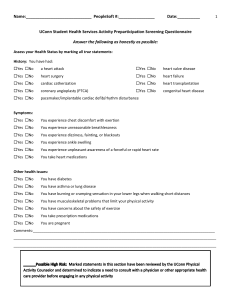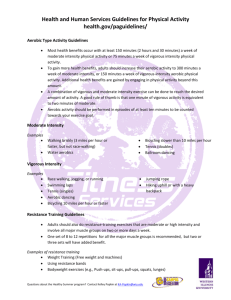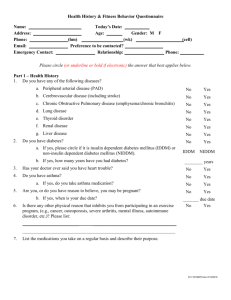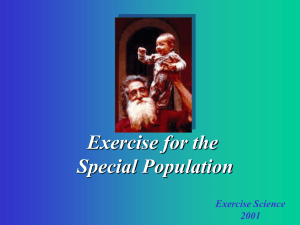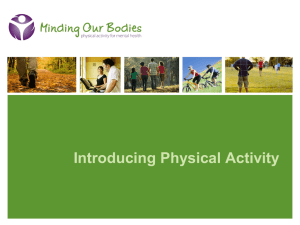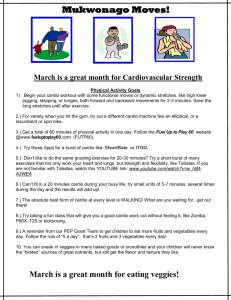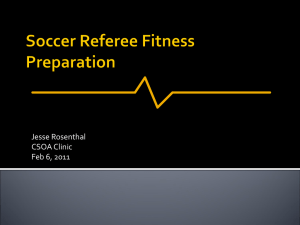Course Objectives: - UICCP Health Science
advertisement
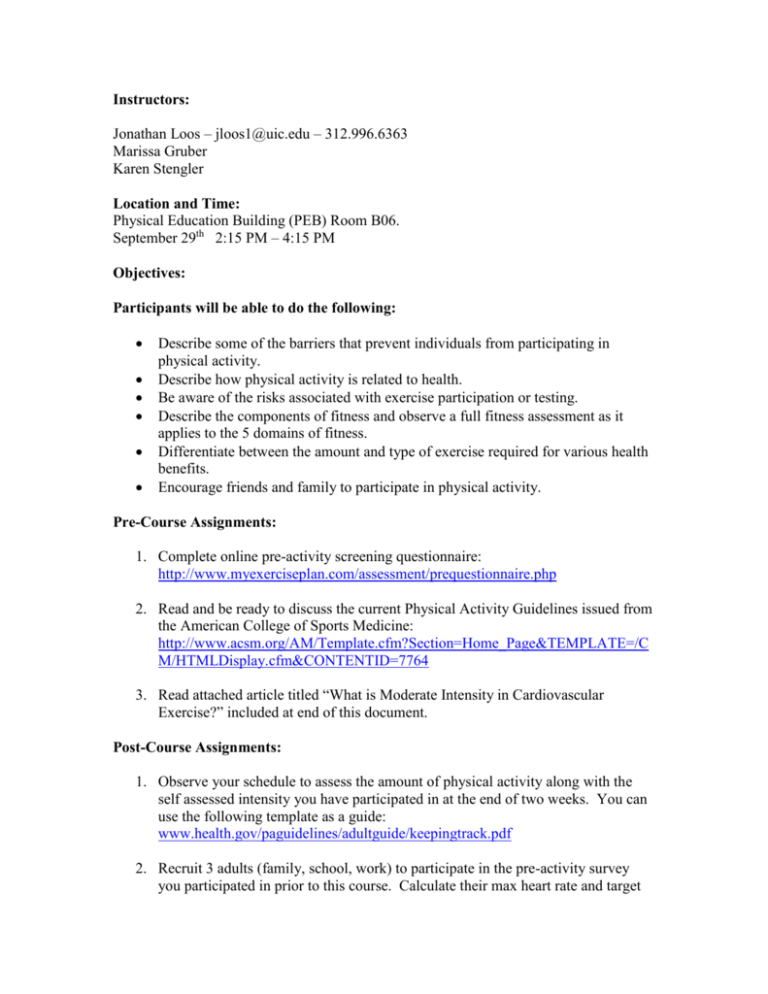
Instructors: Jonathan Loos – jloos1@uic.edu – 312.996.6363 Marissa Gruber Karen Stengler Location and Time: Physical Education Building (PEB) Room B06. September 29th 2:15 PM – 4:15 PM Objectives: Participants will be able to do the following: Describe some of the barriers that prevent individuals from participating in physical activity. Describe how physical activity is related to health. Be aware of the risks associated with exercise participation or testing. Describe the components of fitness and observe a full fitness assessment as it applies to the 5 domains of fitness. Differentiate between the amount and type of exercise required for various health benefits. Encourage friends and family to participate in physical activity. Pre-Course Assignments: 1. Complete online pre-activity screening questionnaire: http://www.myexerciseplan.com/assessment/prequestionnaire.php 2. Read and be ready to discuss the current Physical Activity Guidelines issued from the American College of Sports Medicine: http://www.acsm.org/AM/Template.cfm?Section=Home_Page&TEMPLATE=/C M/HTMLDisplay.cfm&CONTENTID=7764 3. Read attached article titled “What is Moderate Intensity in Cardiovascular Exercise?” included at end of this document. Post-Course Assignments: 1. Observe your schedule to assess the amount of physical activity along with the self assessed intensity you have participated in at the end of two weeks. You can use the following template as a guide: www.health.gov/paguidelines/adultguide/keepingtrack.pdf 2. Recruit 3 adults (family, school, work) to participate in the pre-activity survey you participated in prior to this course. Calculate their max heart rate and target heart rate and explain to them, as per the ACSM Healthy Adult Guidelines, moderate exercise and vigorous exercise as it relates to heart rate. Itinerary: Discuss Risk Stratification and results from online questionnaire required before class. Discuss Physical Activity guidelines from the American College of Sports Medicine. Discuss the differences between Moderate Intensity Exercise vs. Vigorous Intensity Exercise. Demonstrate and practice finding radial pulse and assessing resting heart rate. Discuss and calculate maximum heart rate prediction and target heart rates. Explore the definition of fitness and the domains contained within. Observe full fitness assessment covering all of the domains of fitness. Discuss assignment activity End What Is Moderate Intensity in Cardio Exercise? Overview Moderate cardiovascular exercise comes in many forms. It's often difficult for the novice exerciser to determine how hard to train during exercise. Gauging intensity is an extremely useful skill that can be learned using various techniques. Once an exerciser becomes accustomed to exercising moderately, it is easier to progress to more intense exercise and yield even greater physical results. Significance Engaging in moderate intensity cardio exercise regularly helps maintain and improve health. The Physical Activity Guidelines published jointly by the American College of Sports Medicine (ASCM) and the American Heart Association (AHA) recommend "moderately intense cardio 30 minutes a day, 5 days a week," but they also note that this recommendation is intended for already healthy individuals to maintain good health and reduce the risk for chronic disease. Up to 60 to 90 minutes each day may be required for those trying to lose weight.1 Features Moderate cardio is exercise that is vigorous enough to produce sweating, increase breathing and elevate the heart rate but a conversation can still be maintained while moving. Use the rate of perceived exertion (RPE) scale to classify the level of difficulty experienced while exercising. On a scale of one to 10, moderate cardio should feel like a level five to six in difficulty. Heart rate also can be used to gauge intensity. Aim to stay within a target heart rate zone that is 55 to 70 percent of your maximum heart rate to exercise moderately. Calculate your max heart rate by subtracting your age from 220. Types Choose from a variety of moderate intensity cardio exercises to reach the recommended amount each week: brisk walking, easy jogging, dancing, bicycling on a level surface, swimming, racquetball, tennis, basketball, touch football, housework or yard work. Any type of sport or activity counts. As long as an increased heart rate is maintained throughout the duration of time spent doing the activity, it is considered to be moderate intensity cardiovascular exercise. Considerations Evidence shows that moderate cardio does benefit individuals who otherwise would be sedentary, but higher intensity exercise has an even more profound effect on reducing cardiovascular and other health risks. In a comparison study of moderate and higher intensity cardio, the "Journal of American Cardiology" found that, "All of the epidemiology studies that controlled for energy expenditure found greater cardioprotective benefits from the higher aerobic exercise intensities as compared to the moderate aerobic exercise intensities."2 Benefits Moderate intensity cardio is extremely beneficial in reducing the risk of depression and chronic disease. For sedentary individuals, it serves to condition the heart, joints and muscles slowly as the body becomes better able to handle more intense activities. It functions well as a starting point for those looking to lose weight and people who have a goal of increasing time spent exercising moderately and/or increasing the intensity of the exercise itself. Moderate cardio coupled with a healthy diet is the safest way to achieve weight loss and ultimately reduce other health complications related to being overweight or obese. References 1. American College of Sports Medicine: Physical Activity Guidelines 2. American Journal of Cardiology: Comparison study
